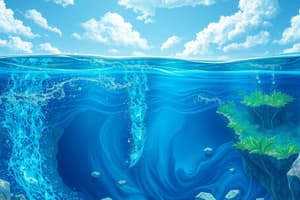Podcast
Questions and Answers
What drives the water cycle?
What drives the water cycle?
- Ocean currents
- Wind's energy
- Sun's energy (correct)
- Earth's rotation
Which pollutants can contribute to water pollution?
Which pollutants can contribute to water pollution?
- Heavy metals and bacteria (correct)
- Carbon dioxide and oxygen
- Carbon monoxide and sulfur dioxide
- Nitrogen and phosphorus
What is the main characteristic of point source pollution?
What is the main characteristic of point source pollution?
- Occurs randomly in the water cycle
- Originates from natural phenomena
- Comes from various unidentified sources
- Originates from a single identifiable source (correct)
What does water treatment aim to do?
What does water treatment aim to do?
What happens after water evaporates from the Earth's surface?
What happens after water evaporates from the Earth's surface?
What is the main difference between point source pollution and non-point source pollution?
What is the main difference between point source pollution and non-point source pollution?
Which water treatment method uses living organisms to break down organic matter and remove pollutants?
Which water treatment method uses living organisms to break down organic matter and remove pollutants?
What is the purpose of chemical treatment methods in water treatment?
What is the purpose of chemical treatment methods in water treatment?
Which source of pollution is more likely to result from erosion and land-use activities?
Which source of pollution is more likely to result from erosion and land-use activities?
What are some examples of physical treatment methods in water treatment?
What are some examples of physical treatment methods in water treatment?
Flashcards are hidden until you start studying
Study Notes
Water: An Essential Resource and Its Challenges
Water, a fundamental element that sustains life on our planet, plays a vital role in our daily lives, from quenching thirst and nourishing crops to driving industries and sustaining ecosystems. However, as our global population grows and our demand for natural resources intensifies, water faces challenges that impact its quality, availability, and sustainability. In this article, we will explore the water cycle, water pollution, and water treatment – three critical aspects that shape the world's water resources.
The Water Cycle
The water cycle, a continuous process driven by the sun's energy, describes how water moves on, above, and within the Earth's surface. This cycle involves the evaporation of water from the Earth's surface, its subsequent condensation into clouds, and precipitation, which includes rain, snow, and hail. Water then flows into rivers, lakes, and oceans, and eventually returns to the atmosphere.
Water Pollution
The quality of our water resources is diminishing due to human activities that discharge pollutants into water systems. These pollutants, which can come from point and non-point sources, include chemicals, heavy metals, bacteria, sediment, and plastics, among others. Water pollution can be categorized into two main types:
-
Point source pollution originates from a single, identifiable source, such as a factory or sewage treatment plant. Examples include the discharge of untreated wastewater from factories and industrial operations, as well as the spillage of oil and hazardous materials into water bodies.
-
Non-point source pollution, on the other hand, stems from diffuse sources and is more challenging to identify and control. Examples include agricultural runoff, urban stormwater runoff, and contaminated groundwater. Non-point sources often result from erosion and other land-use activities that allow pollutants to enter water systems.
Water Treatment
Water treatment is a critical process that aims to remove pollutants from water, making it safe for human consumption, irrigation, and industrial use. There are various treatment methods, including:
-
Physical treatment methods remove large particles, suspended solids, and debris from water. Filtration, sedimentation, and screening are some examples of physical treatment methods.
-
Chemical treatment methods use chemicals to disinfect or remove pollutants from water, such as chlorine and coagulants. Chemical treatment methods are used to remove dissolved organic matter, heavy metals, and pathogens.
-
Biological treatment methods use living organisms, such as bacteria and algae, to break down organic matter and remove pollutants from water. Biological treatment methods are used to remove nutrients like nitrogen and phosphorus, as well as organic matter.
Water Treatment Challenges
While water treatment technologies have advanced, they face several challenges, such as increased demand for clean water, the emergence of new contaminants, and water scarcity. These challenges necessitate innovative and sustainable solutions to ensure the safety and availability of drinking water and the protection of aquatic ecosystems.
In conclusion, water is a vital resource that sustains life and drives the economy. However, its quality and availability are being threatened by pollution and overexploitation. Understanding the water cycle, water pollution, and water treatment is crucial for combating these challenges and ensuring the sustainability of our water resources. By working together, we can develop innovative and sustainable solutions to protect and preserve our water for generations to come.
Studying That Suits You
Use AI to generate personalized quizzes and flashcards to suit your learning preferences.




